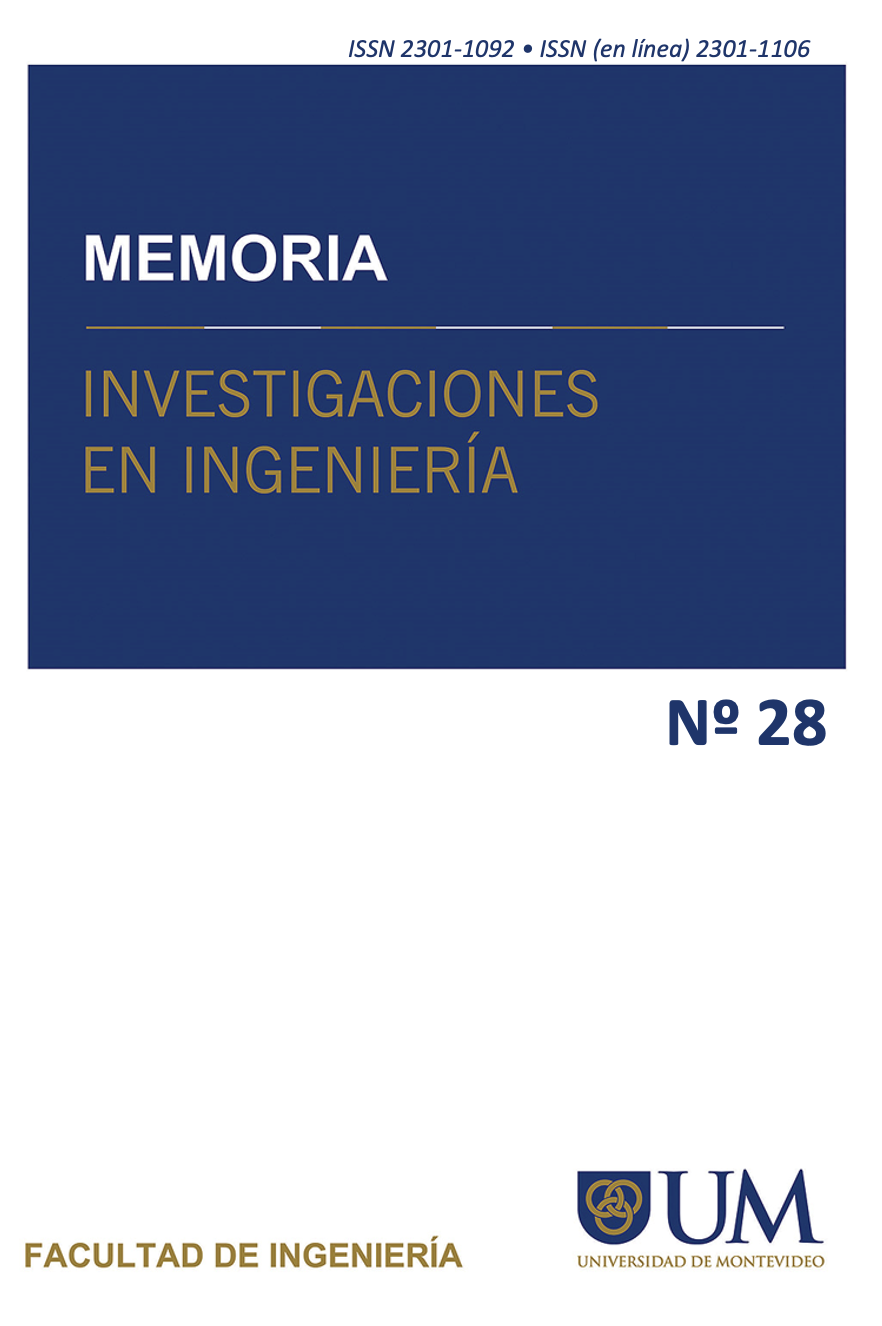Mechanical Characterization of Post weld quenched Al 6082-T6 TIG welded Joints
DOI:
https://doi.org/10.36561/ING.28.6Keywords:
TIG welding, mechanical properties, Al 6082-T6, quenching mediaAbstract
This research aims to enhance the efficiency of weld joints through a cost-effective methodology. Aluminium 6082-T6 is the chosen material due to its frequent use in applications that require intermediate strength with low weight. Welding operations typically lead to a weakening of material strength by up to 50% due to the high input heat. Therefore, the focus of this study is to improve the strength by employing quenching techniques with different media, such as sand, water, and hydraulic oil. A comparative analysis of the mechanical properties is performed based on the quenching of weld joints using these various media. Additionally, microstructure examination is conducted to facilitate this comparative study. The mechanical properties investigated include hardness, tensile strength, yield strength, and toughness, with the goal of understanding the impact of different quenching media. The research reveals that water-cooled joints exhibit higher yield strength, while oil-cooled joints demonstrate superior tensile strength compared to other joints. Furthermore, the ductility of oil-cooled joints is notably higher, as measured by % elongation. Water cooling leads to noteworthy hardness in both the Weld Zone (WZ) and Heat-Affected Zone (HAZ) due to rapid cooling. In contrast, the hardness of oil-cooled joints is not significantly different from that of water-cooled welded joints. Regarding toughness, oil-cooled joints show greater impact energy in the HAZ compared to those quenched with water, sand, and air. However, in the WZ, air-cooled joints exhibit superior impact energy, which directly indicates better toughness properties. Therefore, oil-cooled joints display higher toughness in the HAZ, while air-cooled joints are tougher in the WZ. Overall, the mechanical properties of oil-cooled joints are significantly enhanced, leading to an improved weld efficiency from 55% to 72%.
Downloads
References
Baskutis, S., Bendikiene, R., & Ciuplys, A. (2019). Effect of weld parameters on mechanical properties and tensile behavior of tungsten inert gas welded AW6082-T6 aluminum alloy. Journal of Mechanical Science and Technology, 33(2), 765–772. DOI: https://doi.org/10.1007/s12206-019-0131-6
Kaba, L., Djeghlal, M. E., Ouallam, S., & Kahla, S. (2021). Dissimilar welding of aluminum alloys 2024 T3 and 7075 T6 by TIG process with double tungsten electrodes. International Journal of Advanced Manufacturing Technology, 118, 937–948. DOI: https://doi.org/10.1007/s00170-021-07888-5
Kumar, A., & Sundarrajan, S. (2009). Effect of welding parameters on mechanical properties and optimization of pulsed TIG welding of Al-Mg-Si alloy. International Journal of Advanced Manufacturing Technology, 42(1-2), 118–125. DOI: https://doi.org/10.1007/s00170-008-1572-8
Kumar, K., Kumar, C. S., Masanta, M., & Pradhan, S. (2022). A review on TIG welding technology variants and its effect on weld geometry. Materials Today: Proceedings, 50, 999-1004. DOI: https://doi.org/10.1016/j.matpr.2021.07.308
Li, J.-f., Zheng, Z.-q., Na, J., & Tan, C.-y. (2005). Localized corrosion mechanism of 2XXX series Al alloy containing S(Al2CuMg) and (Al2Cu) precipitates in 4.0% NaCl solution at pH 6.1. Journal of Materials Chemistry and Physics, 91, 325−329. DOI: https://doi.org/10.1016/j.matchemphys.2004.11.034
Miao, W. F., & Laughlin, D. E. (1999). Precipitation hardening in aluminum alloy 6022. Elsevier Science, 40(7), 873–878. DOI: https://doi.org/10.1016/S1359-6462(99)00046-9
Murali, N., & Li, X. (2021). TIG welding of dissimilar high-strength aluminum alloys 6061 and 7075 with nano-treated filler wires. In L. Perander (Ed.), The Minerals, Metals & Materials Series. Springer. DOI: https://doi.org/10.1007/978-3-030-65396-5_47
Muzamil, M., Wu, J., Samiuddin, M., Majeed, A., Siddiqui, S. U., & Mudassir, M. (2020). Macro-mechanical behavior of unique surface welded joints (AA5083) utilizing tungsten inert gas welding against single-stage homogenization annealing. Revista de Metalurgia, 56(3), e173. DOI: https://doi.org/10.3989/revmetalm.173
Prabhukhot, A. R., & Prasad, K. (2015). Effect of heat treatment on hardness of 6082-T6 aluminum alloy. International Journal of Scientific & Engineering Research, 6.
Rajkumar, T., Prabakara, M. P., Arunkumar, G., & Antony, A. G. (2020). Study on the feasibility in welding of low carbon steel and austenitic stainless steel joint using CO2 laser welding process and analysis of its metallurgical and mechanical properties. Wu Tan Hua Tan Ji Suan Ji Shu, 106(5), 471–476.
Rajkumar, T., Raja, K., Lingadurai, K., Vetrivel, S. D., & Antony, A. G. (2020). Interfacial microstructure analysis of AA2024 welded joints by friction stir welding. Journal of New Materials for Electrochemical Systems, 23(2), 123–132. DOI: https://doi.org/10.14447/jnmes.v23i2.a09
Reboul, M. C., & Baroux, B. (2011). Metallurgical aspects of corrosion resistance of aluminum alloys. Journal of Materials and Corrosion, 62, 215−233. DOI: https://doi.org/10.1002/maco.201005650
Shazad, A., Astif, M., Uzair, M., & Zaidi, A. A. (2024). Evaluation of preheating impact on weld residual stresses in AH-36 steel using Finite Element Analysis. Memoria Investigaciones en Ingeniería, (26), 225-243. DOI: https://doi.org/10.36561/ING.26.14
Shazad, A., Jadoon, J., Uzair, M., & Akhtar, M. (2022). Effect of composition and microstructure on the rusting of MS Rebars and ultimately their impact on mechanical behavior. Transactions of the Canadian Society for Mechanical Engineering. DOI: https://doi.org/10.1139/tcsme-2021-0207
Shazad, A., Uzair, M., Jamil, T., & Muhammad, N. (2024, December). A Comparative Study on the Joint Hardness and tensile properties of Dissimilar Aluminum Alloy using Tungsten Inert Gas (TIG) Welding. In 4th International Conference on Key Enabling Technologies (KEYTECH 2024) (pp. 173-178). Atlantis Press. DOI: https://doi.org/10.2991/978-94-6463-602-4_25
Shazad, A., Uzair, M., & Tufail, M. (2024). Influence of multiple post-weld repairs on mechanical and microstructural properties of butt weld joint utilized in structural members. International Journal of Precision Engineering and Manufacturing, 1, 1–8. DOI: https://doi.org/10.1007/s12541-024-01104-6
Sathish, T., Armalingam, S., Mohanavel, V., et al. (2021). Weldability investigation and optimization of process variables for TIG-welded aluminum alloy. Advances in Materials Science and Engineering. DOI: https://doi.org/10.1155/2021/2816338
Tan, C. F., & Said, M. R. (2009). Effect of hardness test on precipitation hardening aluminum alloy 6061-T6. Science Journal, 36(3), 276–286.
Zhu, J., Jiang, W., Li, G., Guan, F., Yu, Y., & Fan, Z. (2020). Microstructure and mechanical properties of SiCnp/Al6082 aluminum matrix composites prepared by squeeze casting combined with stir casting. Journal of Materials Processing Technology, 283, 116699. DOI: https://doi.org/10.1016/j.jmatprotec.2020.116699























